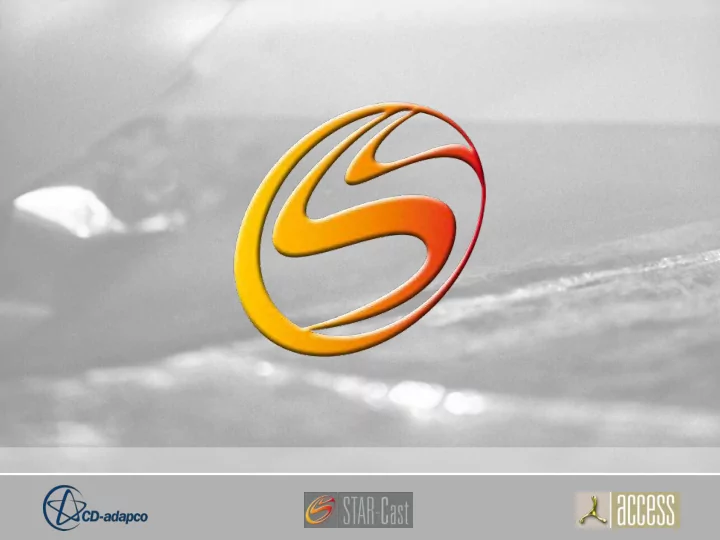

Simulation of Centrifugal Casting via STAR-Cast Santhanu Jana, Access e.V., Aachen
Talk overview Centrifugal casting STAR-Cast‘s modelling basis Motivation for centrifugal investment casting Centrifugal investment casting of ● Low pressure turbine blades ● Turbocharger wheels Future work
Introduction to centrifugal casting Centrifugal forces distributes the molten material in the mould Top rollers Rotation axis may be horizontal, vertical or inclined Casting Preferred for high quality cast parts Rolls, nozzles, wheels, jewellery, Liquid metal Bottom etc Mould Coating rollers Casting materials: iron ,steel, Schematic of horizontally rotated alloys of Aluminium, Copper, bimetallic casting Titanium etc
Modelling basis in STAR-Cast
STAR-Cast‘s modelling approach Coupled flow and solidification model : Multi phase approach: gas, liquid and solidified metal ● HRIC: ensures sharp resolution of free surface, entrapped gas bubbles ● Porous walls: Escape of gas through shell moulds ● Interfacial forces: Surface tension and wetting angle effects ● Rotational forces : are modeled based on rotating frame of reference ● Moving grids: to model crucible tiling and pouring into the funnel Polyhedral meshes: for complex geometries and multiphysics simulations Material data: Comprehensive and fully documented data dedicated for casting simulation High performance computing: Scales almost linear on parallel machines down to 10.000 cells per processor: STAR-Cast Power Version
STAR-Cast‘s modelling approach Advanced liquid-solid state transition model ● Resistance to flow is a function of secondary dendrite arm spacing Solid Mushy Liquid f L = 0.0 f L = 0.3 f L = 1.0
Motivation for centrifugal investment casting
Casting of TiAl components with centrifugal investment process Aero-engine manufacturers are introducing using new light weight materials Intermetallic TiAl alloys ● 50% lower weight compared to conventional Ni-based alloys. Centrifugal investment casting can deliver high quality requirements Ni basis Vs. TiAl blades
Near-net-shape parts manufacture of Titanium Aluminides HPC Vanes LPT Blades Medical Implant Turbocharger Wheel But a difficult material to cast ● Potential of misrun ● Components like LPT blades have trailing edges of around 0.5 mm
Centrifugal Investment Casting of Low Pressure Turbine (LPT) Blades
Typical casting defects in LPT blades Misruns Porosity Ceramic Particles Hot tearing Gas entrapments Ceramic breakouts The foundry engineer faces an uphill task!!!!
Centrifugal investment casting LPT Blades Process characteristics Tilting Induction Skull Melting Copper Two chamber system Crucible Separation valve Melting capacity: 10.0 kg (open) Melt Heating (optional 25 kg) box Melting chamber Rotation speed:0-400 rpm Casting chamber Mould filling in 1.5 seconds Sprue Melt distributor Rotation Rotating table
Simulation of the pouring process STEP 1: Simulate the crucible pouring process moving grids Metal flow Velocity field Wetting
Simulation of the pouring process Obtain inlet mass flow rate for the casting cluster Optimize the pouring process Skull weights on funnel Funnel outflow
Simulation of the casting cluster of LPT blades STEP 2: Simulate the casting cluster ● Generate the shell mould and mesh ● Apply inlet, initial and boundary conditions ● Use appropriate time step size (around 1.0e-4s) ● Solve on a high performance computing cluster (With around 72 processors total computing time is 4 days) Objectives: ● Predict misruns : i.e., if a fully filled blade is achievable or not
Typical casting cluster of LPT Blades Inlet Distributor LPT blade Rotating at 200 RPM Ingates Runner
Generation of shell mould and mesh Polyhedral mesh on shell mould Total mesh size :3 million cells
Simulations of casting cluster Rotating at 200 RPM
Simulations of casting cluster Rotating at 200 RPM
Result from Casting Trials
Comparison of casting trials and simulation predictions
Final outcome!!!! Simulations Casting designs Next time anyone flying on an aircraft fitted with these blades be assured it has been developed using state-of-the-art tool STAR-Cast
Centrifugal investment casting of TiAl turbocharger wheels
Centrifugal investment casting TiAl turbo charger wheel Centrifugal investment casting furnace, shell mold and turbocharger wheel
Centrifugal investment casting TiAl turbo charger wheel Process characteristics Melting capacity: 2.0 kg (max) 1 Chamber process
Centrifugal investment casting TiAl turbo charger wheel Ceramic shell mold Wrapping around parts calculated using the STAR- slows down the solidification Cast shell mold generator process
Centrifugal investment casting TiAl turbo charger wheel
Centrifugal investment casting TiAl turbo charger wheel spinning
Future work Multiple frame of references coupled with solidification Centrifugal casting of multiple alloys Particle tracking during mould filling Coupling to thermomechanics
Special Thanks !!
Recommend
More recommend